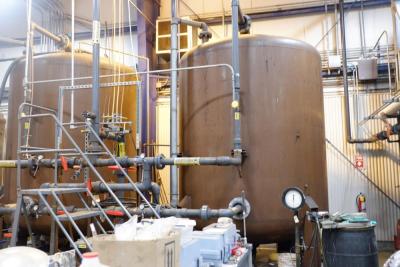Re-Solve Group shares remediation efforts at EPA Superfund site


From 1956 to 1980, the Re-Solve facility located at 1275 North Hixville Road served as a waste chemical reclamation site.
But in the 1980s, the EPA desigated the facility a Superfund site, and the responsible parties, who sent chemical contributions to the site, now fund the effort to clean up the contaminated soil and groundwater.
While some Superfund sites are taxpayer supported, the Hixville site is fully funded by the responsible parties. The EPA does not keep a running total of the funds expended at the site, but Public Affairs Officer Jo Anne Kittrell estimated the number at $30 million.
The group of responsible parties, called the Re-Solve Site Group, contracted the services of Tetra Tech and Weston Solutions, who actually do the cleanup work.
In an effort to make their mission more transparent to the residents of Dartmouth, an open house and tour was held Wednesday, Oct. 18.
Michael Last, executive director for the Re-Solve Superfund Site Group, said the site originally operated like a recycling facility, taking in waste solvents, then reprocessing and distilling them to be reused by the industrial customers.
However, some of the materials sent to the facility could not be recycled and ended up in unlined lagoons, he added. The chemicals from these lagoons then contaminated the soil and seeped down to the bedrock where it then polluted the groundwater, including PCBs, which are chemicals formerly used in industrial and consumer products.
Because of that pollution, the Environmental Protection Agency included the facility on its National Priorities List and has established this Superfund group to remediate it.
As part of the remedial process, a total of 52,000 cubic yards of soil was removed, sent through a low-temperature thermal treatment facility and then placed back on site with a layer of crushed stone on top.
There is no similar quick solution available to clean the groundwater.
Speaking on the treatment process, Last said, “It's been a great success actually, but our challenge — and there's no kind of solution to this — is that because the contamination got into the bedrock, it comes out very slowly from the rock.”
“It's going to be a very long time, we think, before all that comes out of bedrock, gets cleaned up and all of the standards essentially get met,” Last said.
The Re-Solve group dug eight wells at varying depths to extract the contaminated groundwater and send it to the on-site facility through a two-layered piping system for treatment.
He said the facility’s goal over the last decade has been creating a “sustainable remedy.”
This includes using less electricity, less chemicals and producing less waste.
Fred Symmes, a Weston project manager, explained the original treatment process used a lot of chemicals that produced a lot of sludge.
He said he and Last saw how the water was naturally becoming decontaminated as it went through the facility due to the bacteria and worked to create a process that would allow special bacteria to break down the chemicals more efficiently and effectively.
This new process was tested for five years and pitched to the EPA before it was put into place in 2012.
However, the PCBs cannot break down naturally, so the water goes through two large carbon vessels, according to Symmes. Then, 99% of the PCBs are able to stick to the carbon before it is sent to the outdoor biological treatment system.
The outdoor system includes two beds with 10 pipes coming up from each where the groundwater will trickle out and back into the ground through layers of peat and sand, according to Symmes.
This is where the bacteria is able to comfortably grow and break down additional contaminants.
The water then sinks to the bottom where a gravel drain layer with pipes will send it back into the facility where it is run through additional carbon vessels as a backup before sent into the Copicut River.
The facility also has its own solar panels, which provide all of the site’s energy.
Melanie Morash, a remedial project manager from the EPA, said the wetlands, which take up one of the six acres of the property, are now fully restored.
Symmes said the facility’s outfall is tested twice monthly by the EPA.















